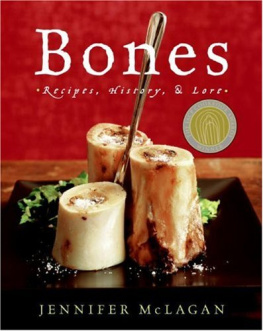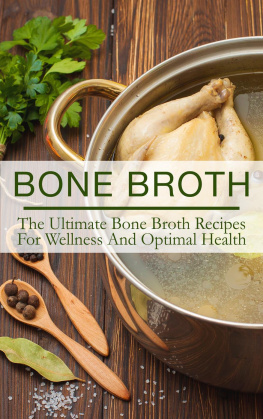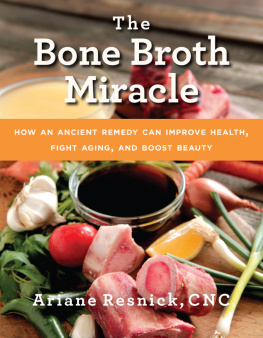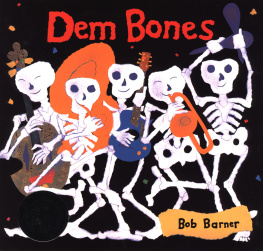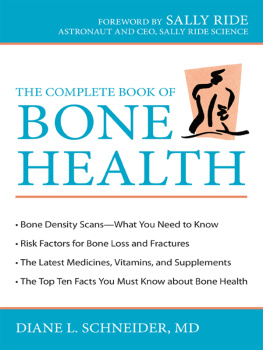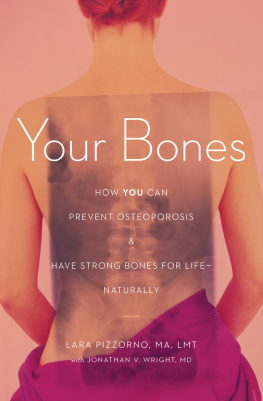L ooking back to my childhood, I dont remember either of my grandmothers ever cooking a single meal, but I do remember eating and I know that the appreciation of good food, all the way down to its bones, began early for me. Meal times were important and the food was plain but good. My mother, Claudine, and her sisters, my aunts, Pat and Joyce, cooked because thats what wives and mothers did. They were frugal, able to make a meal out of almost nothing. From them, right from the start, I learned that food was valuable and not to be wasted, an important lesson, and I thank them for that.
As a professional cook, I have been influenced by a host of chefs, cooks, and food writers whom Ive met through my work, in my travels, and through reading their books. Special thanks go to Chris McDonald of Avalon restaurant, and Andrew Milne-Allan and Louis Alves of Zucca restaurant.
A cook is nothing without quality products. Writing this book and testing recipes, I relied on old friends and discovered new ones: Leila Batten and Stanley Janecek at Whitehouse Meats, John Rietkerk at Second Wind Elk, Elizabeth and Peter Bzikot and their sheep, Chang Lin at Pisces Fish, and Mary Lou Dolan at Beretta Organic Farms. My butcher in Paris deserves special mention. Watching Jol Lachable work is a joy and an education. It reveals the art form that is good butchery. I often dont want to cook the meat he has prepared; I am content to just to admire its beauty.
Writing is a solitary task, so the help and encouragement of friends is invaluable. Pat Holtz, who always encourages me and even manages to write wonderful words about me; Miriam Rubin, who tested, read, edited, and explained American idiosyncrasies; and Heather Trim, who gave valuable advice and tested my recipes. Thank you.
Many people volunteered to taste my cooking and they deserve thanks. It is not always an enjoyable task or easy pinpointing why you like or dislike a recipe. I have many friends with fine palates, who, even more important, are not afraid to criticize. Those who know me well realize just how brave these individuals are. Thank you to Karen Lim and Vincent Wong, Franois and Caroline Gerard, Val and Ilze Lapsa, Eric and Marie-line Incarbona, Nancy Shanoff and Peter Weis, David Field, Jacques Fortier, and Oksana Slavyutch, who all happily ate anything I put in front of them and told me exactly what they thought of it.
Other friends discovered unusual bone facts, researched information, and passed on recipes. Francois Gerard; Hiroko Sugiyama; David Field; Laura de Turckheim; Melinda Leong, her colleagues at the Deutsche Gesellschaft fur Technische Zusammenarbeit (German Technical Cooperation), and her mother Ruby Leong; James Tse; Sally Coles; Robyn McAlister; and Uta Taylor, to all of you I am grateful.
You meet lots generous people in food writing and I would like to express my gratitude to my editors, Amy Albert, Jody Dunn, and Pat Holtz, and to authors Jeffery Alford, Naomi Duguid, and Rosie Schwartz. All of them supported me and provided good sound advice.
I am grateful to those who didnt know me but sent information and answered my questions after we met via the Internet: Barbara Ketcham Wheaton, Andrew Smith, and Bruce Aidells.
Merci beaucoup Laura Calder. Laura and I both began writing book proposals at the same time. Laura finished her proposal and book long before me, however, and then shared with me much useful insider information. She cheered me on throughout and even introduced me to Harriet Bell before my agent had a chance to do so.
As I have no platform or a line of cookware to my name I would not have had a chance to write this book without the foresight and risk-taking of my agent, Rebecca Staffel of the Doe Coover Agency. Thank you Rebecca and Doe, who took up the torch from Rebecca partway along.
Perhaps even braver was Harriet Bell, editor at William Morrow. Right from that first breakfast in Montral she was enthusiastic about this project. As time passed we discovered friends and interests we shared, especially a love of France. Without Harriets support, honesty, and patience, I would never have arrived here, and for that I am very grateful. All the team at HarperCollins deserves praise, especially Lucy Baker, Leah Carlson-Stanisic, and Carrie Bachman and Judith Sutton.
The visuals of this book were extremely important to me. Luckily, over the years I have met and become friends with many very talented designers, photographers, and stylists who have become my friends. Thank you to Lim Graphics, especially Karen Lim and Paola Beltrame, for helping to clarify my ideas. I was thrilled when photographers Rob Fiocca and Colin Faulkner agreed to work on Bones. To them and their coworkers, Jim Norton, Irene Hullah, Daniela Fiocca, and Julia Francisco, without whom neither of them could function, a sincere thank-you. The prop stylist is the unsung hero of a photography shoot, especially when working with a small budget. The artistic, resourceful Catherine MacFadyen worked wonders for this book, even cajoling her family into helping, so thank you to her and to her daughter Piper, who carried props back on the train from Montral.
I wanted people to understand animal skeletons, but I wanted the illustrations to be fun as well as informative. So I turned to my friend Rene Zamic; a brilliant illustrator, Rene took on the project with enthusiasm. Suffice it to say, he is now an expert on any bone he finds on his plate.
I am saving until last the person to whom I am most grateful, my husband, Haralds Gaikis. It is not easy to live with someone writing a book, especially when you are asked to regularly criticize and comment on what your partner is doing. Haralds willing ate his way through the recipes, daring to critique what was presented and so improved the final result.
Most important, he never doubted my ability to do it. Thank you Haralds, thanks for the twenty-five years we have shared. I look forward to the next twenty-five.
Toronto 2005
Aidells, Bruce, and Denis Kelly. The Complete Meat Cookbook. Boston: Houghton Mifflin, 1998.
Alexander, R. McNeil. Bones: The Unity of Form and Function. New York: Nevraumont Publishing, 1994.
Alexander, Stephanie. The Cooks Companion. Australia: Viking, 1996.
Ammer, Christine. The American Heritage Dictionary of Idioms. Boston: Houghton Mifflin, 1997.
Andrews, Coleman. Close to the Bone. Saveur no. 10.
Ayrton, Elizabeth. The Cookery of England. Australia: Penguin, 1977.
Ayto, John. The Diners Dictionary. New York: Oxford University Press, 1993.
Bittman, Mark. Fish. New York: Wiley, 1999.
Bocuse, Paul. La Cuisine du Gibier. Paris: Flammarion, 2000.
Boxer, Arabella. A Visual Feast. London: Random Century House, 1991.
Child, Julia, Louisette Bertholle, and Simone Beck. Mastering the Art of French Cooking, vol. 1. 40th anniversary edition. New York: Knopf, 2001.
Claiborne, Craig. The New York Times Food Encyclopedia. New York: Times Books, 1985.
Colwin, Laurie. Home Cooking. New York: HarperCollins, 1988.
_______. More Home Cooking. New York: HarperCollins, 1993.
Conran, Terence, and Caroline Conran. The Cookbook. New York: Crown, 1980.
Corriher, Shirley. CookWise. New York: William Morrow, 1997.
Daguin, Ariane, George Faison, and Joanna Pruess. DArtagnans Glorious Game Book. Boston: Little, Brown, 1999.
David, Elizabeth. Spices, Salts, andAromatics in the English Kitchen. Australia: Penguin, 1981.
Davidson, Alan. The Oxford Companion to Food. Oxford: Oxford University Press, 1999.
______. Seafood. New York: Simon & Schuster, 1989.

